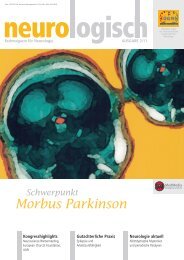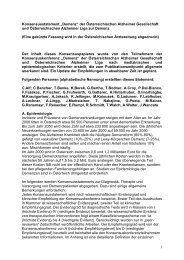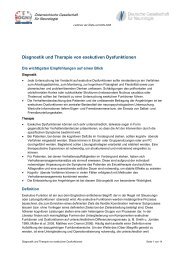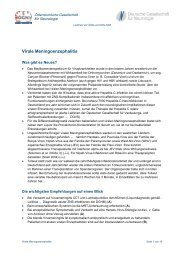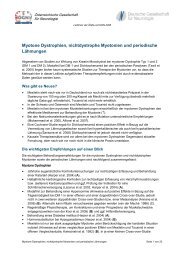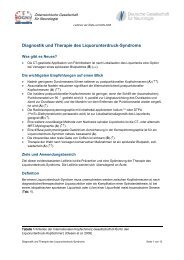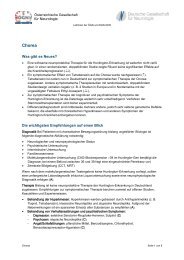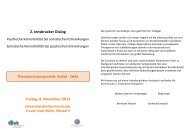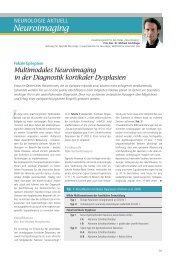neurologisch - Ãsterreichische Gesellschaft für Neurologie
neurologisch - Ãsterreichische Gesellschaft für Neurologie
neurologisch - Ãsterreichische Gesellschaft für Neurologie
Erfolgreiche ePaper selbst erstellen
Machen Sie aus Ihren PDF Publikationen ein blätterbares Flipbook mit unserer einzigartigen Google optimierten e-Paper Software.
NEUROLOGIE AKTUELL<br />
Autonome Störungen<br />
Häufig werden PatientInnen<br />
mit Schweißsekretionsstörungen<br />
in Labors für autonome<br />
Funktionsdiagnostik vorgestellt.<br />
Wenn man als Ursache eine<br />
„Small fibre“-Neuropathie<br />
vermutet, so ist die Sicherung der<br />
Diagnose eine Herausforderung.<br />
Zur Verfügung stehen die<br />
quantitative sensorische Testung<br />
(QST) oder der quantitative<br />
sudomotorische Axonreflextest<br />
(QSART). Eine exaktere Diagnose<br />
ist allerdings über die Hautbiopsie<br />
möglich. Während QST und<br />
QSART nur in wenigen Labors<br />
zur Verfügung steht, wird die<br />
Hautbiopsie von DermatologInnen<br />
häufig durchgeführt.<br />
Dr. Casanova-Mollá und Dr. Josep<br />
Valls-Solé haben die Diagnostik<br />
der Hautbiopsie in den letzten<br />
Jahren verfeinert und präsentieren<br />
eine kurzen Überblick über diese<br />
Technik.<br />
Dr. Walter Struhal<br />
Cutaneous nerve evaluation<br />
Among the different techniques used for the assessment of painful peripheral neuropathies,<br />
the skin biopsy has experienced the biggest growth over the past 15 years. It allows<br />
us to identify the axons of the sensory nerve endings in the skin. The most commonly<br />
used marker is pan-axonal protein gene product 9.5 (PGP 9.5), a ubiquitin C-terminal hydroxylase<br />
that is found in axons. 1 Quantitative and qualitative evaluations of cutaneous<br />
nerves can give support to the clinical diagnosis of small-fibre neuropathies. 2, 3 However,<br />
as it is applicable to other peripheral neuropathies, to autonomic disorders, and to the<br />
study of neuropathic pain, this makes the skin biopsy a powerful tool for the future.<br />
The quantification of intra-epidermal nerve<br />
fibres (IENFs) follows specific precepts that<br />
have been defined through a consensus of<br />
experts. The recommendations published by<br />
the European Federation of Neurological Societies<br />
Task Force 4 have been found to be<br />
very reliable, and to have high inter-observer<br />
and intra-observer agreement coefficients. 5<br />
Briefly, IENFs are counted only when they<br />
cross or originate at the dermal–epidermal<br />
junction, with secondary branching excluded<br />
from this quantification. The skin surface is<br />
measured and the mean of three skin sections<br />
provides the IENF density (IENFD) per linear<br />
millimetre for the subject under study. Normative<br />
values have been published, as adjusted<br />
for age and gender. 6, 7 The IENFD cutoff<br />
values of 7.63 /mm and



